
Drowning and Resuscitation Pages: 1 2 3 4 5 6 7 Next>>
Resuscitation of Drowning Victims at Sea, Page 6
Resuscitation Methods: Stimulating the Victim's Throat
As surprising as it may seem, putting things down a drowning victim's throat was sometimes recommended to resuscitate them. Stephen Bradwell advised that when "the partie be without sense or motion; then also let some one of the standers by, that is
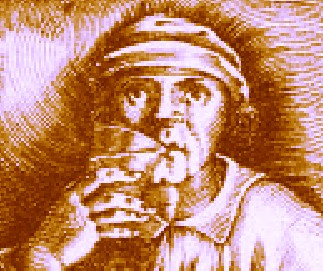
Artist: Jan Van der Straet
Giving Liquid Medicinals, From A Man in Bed
With Syphilis (1600)
of good discretion, put his finger into the parties throat, or take a feather dipped in Linseed oyle, & thrust it into the throat, turning it round therein, to make him vomit."1 Sea surgeon John Atkins suggested "touching the Swallow [throat] with a Feather or armed Probe [probe with a piece of cloth on the end], dipped in a Solution of Sal. Vitriol. [white vitriol or zinc sulfate] will make him throw up the Water"2. The idea here was clearly to get the ingested water out of the victim's stomach.
Liquids were also suggested once the nearly drowned was conscious. Atkins suggested that when the patient had vomited up the offending water "he should be shifted dry and put between his Blankets, with a Draught or two of warm Wine."3 In the treatment of the nearly drowned gardener of Tronningholm, Pechlin reported "plying him with antiapopleptic liquors"4. Sea surgeon John Moyle recommended giving a patient "a dragm of Cordial [alcohol] to revive his spent Spirits, a spoonful of your Aq. Mirabilis [a liquor containing things such as cardamom, cloves, cubeb pepper, ginger, mace and nutmeg soaked in spirit of wine] or Spirit. Vini [brandy], is very good."5 After putting him in a warm bed or hammock, he ordered the surgeon to "give him either Venice Treacle [molasses], or Treacle-water in a glass of Wine and let him sweat upon it, (if the Wine were burnt [brandy] it were better.)"6 The purpose of these elixirs was another way to warm the patient.
Post-GAoP, Stimulating the Victim's Throat
John Wilkinson again gives a theoretical background for why stimulating the throat was useful in drowning cases. He begins by warning that while the victim is still unconscious "it is of no benefit, nay it is even dangerous, to put into the mouth a great many liquids, as they will only tend to continue the suffocation."7 However he does suggest that "a few drops of some irritating or sharp liquor given from time to time, by way of exciting [the body]."8 Wilkinson is again promoting movement of the circulatory system by goading the body into action. He elsewhere states that "attendants should endeavour to excite a re-exertion of the vital functions by other more powerful incentives: sharp stimulating things may be applied to the more sensible parts" including the mouth.9
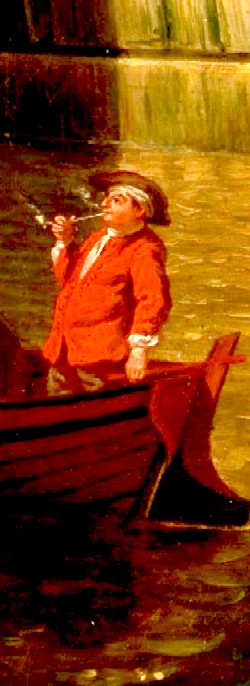
Artist:Samuel Scott
A Smoking Seaman.
From The Arches of
Westminster Bridge (1750)
Bruhier d'Ablaincourt presents another, rather novel, suggestion in his 1746 book The Uncertainty of the Signs of Death. He suggests "by Means of a Quill, or
small Pipe, to blow warm Air into their Mouths, that thus it might be convey'd into their Intestines"10. Although the reason for doing this is not entirely clear, it would presumably push the water out of the victim's system, albeit via a different route.
Like the golden age authors, John Wilkinson advises finding ways to get the patient to get the water out of their system. He suggests using "smoak of tobacco blown into the mouth, to vomit up water it may have received down the throat."11 He also suggests using "a feather tickling the root of the tongue, ...[which will cause the victim] to vomit up water it may have received down the throat."12
Wilkinson is also in favor of getting fluids into the stomach once the victim is conscious.
...as soon as any signs of returning life begin to appear, about six or seven spoonfuls of the oxymel of squills [clarified honey boiled in vinegar of scilla] may be given in warm water; or, if that cannot be had, as will probably be the case, a strong infusion of carduus, chamomile, sage, centaury, hops, and such sorts of herbs, may be administered. Some will, in haste, give warm water with salt in it, and it is not amiss13
This again appears to be an attempt to warm the body. He further suggests, "Pepper boiled in vinegar injected into the mouth is much commended; but indeed any sort of hot sharp liquor may probably answer the same good purpose."14
On the subject of liquids, d'Ablaincourt advises that "Spirituous Liquors ought also to be poured into his Mouth; and where these cannot be had, it is customary to pour warm Urine into it, which has been observ'd to produce happy Effects."15 I haven't found a period equivalent to that last recommendation.
The data from the Dutch society's cases show stimulation of the throat used in 65 of the 148 cases. Before the patient is conscious, they suggest administering drops of liquors, tobacco smoke and stimulating salts as well as tickling the throat (either inside or out) to irritate the patient into awareness. Once awake, they recommend more substantial doses of liquids. Among the substances given to patients by mouth, brandy is the most popular, being used in 37% of the 65 cases. Other substances given by mouth in the Dutch cases include aniseed water, beer, cordials & liquors, gin, limade, milk, tea, wine, butter, olive oil, pepper, sal. ammonia [ammonia salts], salt, sugar and vinegar.
1 Stephen Bradwell, Helps For Suddain Accidents Endangering Life, p.98; 2,3 John Atkins, The Navy Surgeon, p. 269; 4 John Wilkinson, Tutamen Nauticum or The Seaman's Prevention from Shipwreck, Diseases and Other Calamities Incident to Mariners, p. 2; 5 John Moyle, The Sea Chirurgeon, p. 98-9; 6 Moyle,p. 99; 7,8 Wilkinson, p. 8; 9 Wilkinson, p. 6; 10 Bruhier d'Ablaincourt, The Uncertainty of the Signs of Death, p. 207-8; 11,12 Wilkinson, p. 4; 13 Wilkinson, p. 8; 14 Wilkinson, p. 5; 15 d'Ablaincourt, p. 207
Resuscitation Methods: Bleeding the Victim (Post-GAoP Only)
None of the golden age of piracy sources recommend bleeding a victim to revive them. Some suggest bleeding once the victim is revived, but that is a post-operative procedure so we will leave that aside for now.
The sources from after the GAoP have much to say about bleeding, however. John Wilkinson explains,
...if a surgeon be present; he should open the jugular vein, being the large one in the neck, or, if that does not bleed, the temporal artery, being that on the temples; or some other, from which he may draw ten or twelve ounces of blood. ...But bleeding in the foot is not or at least very rarely attended with these good effects; in the arm, seldom; but in the jugular, almost infallibly. ...A drowned person cannot by any easy means be blooded in the extremities.1
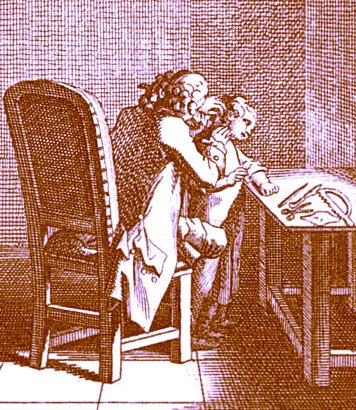
Artist: Daniel Chodowiecki
Bleeding a Child From the Jugular, from J. B.
Basedows' Elementarwerk (1774)
The lack of blood in the extremities is most likely due to the coldness of the victim from being in the water and inactivity. Bruhier d'Ablaincourt concurs with Wilkinson in many respects, noting that, "Venesection is by no Means to be neglected, and perhaps it is most commodiously instituted in the Jugular Vein; for in drown'd Persons"2.
d'Ablaincourt goes on to give his reasoning for why bleeding is needed, suggesting that "the Veins of the Neck are too much distended and choak'd with Blood: Now if these Veins can happily be in some Measure emptied, they will be in a more proper Condition to act upon the Fluid they contain, and which, in order to restore the Patient, they ought to put in Motion.3 Thomas Cogan agrees with d'Ablaincourt, explaining that, "Both the lungs and the brain are loaded with blood, they should therefore be relieved by bleeding."4
Wilkinson's theory of why bleeding should be used is similar, but broader, returning once again to his idea that a lack of circulation is the primary problem for a drowning victim:...bleeding will be of great benefit, for several reasons. 1st, By giving, as bleeding naturally does, an impulse to the blood, as we always find, when it is performed to bring to life those who have fainted away through some impediment in its circulation. 2dly, By this means the oppression and load [of the blood already there] is in the most speedy manner removed from the brain and the lungs. And, 3rdly, this operation alone causes a derivation of the blood from thence.3
Theory notwithstanding, the Dutch society cases bled victims at the arm in the majority of the cases where the location of bleeding is specifically mentioned. Of the 66 cases where bleeding was employed, 22 of them bled the victim at the arm, 5 at the jugular and 3 in the foot. (Frequently the location of bloodletting was not specified. This is true in 42 cases which simply state that bloodletting was used. Non-specific locations often refer to bleeding in the arm in the golden age of piracy era literature, but without more information we cannot state this with certainty.) Given that bleeding at the foot was given such a poor reputation by Wilkinson, it is interesting that surgeon Andrea Antonini specifically states in a case from Alexander Johnson's books that he "bled him [the victim] a second time, in the foot, to give more room for circulation."5
The Failure of Bleeding in Drowning Cases
Even though patients were bled in almost 45% of the Dutch society cases, they don't report it to have been very effective. In agreement with Wilkinson's above comment, bleeding by the arm was particularly troublesome. In one case, Doctor Francisco Antonio Canestrari had the patient "blooded in the right arm, by Borghi the Surgeon, who farther assisted
me in the treatment: but the bleeding not answering my expectation, I got the patient carried to the hospital of Mercy"6. In another case,
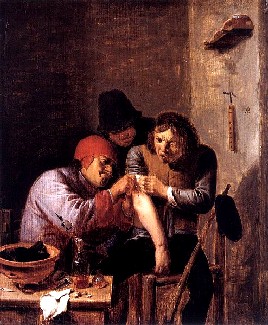
Artist: Adriaen Brouwer
A Difficult Bleeding, From "Feeling" (1635)
"Doctor Diederic van Duyn, who was sent for, ordered Spitz [a dentist] immediately to bleed it [a child], which he did without effect"7. A third case notes that "the Doctor, who was again sent for, took but little blood from her; and what was taken had no good effect" after which the doctor ordered an enema, rubbing and warming for the patient."8
In 1745, Dr. John Fothergill, writing in the The Philosophical Transactions of the Royal Society of London, made a rather direct comment opposing bleeding in drowning cases.
But in too many instances, we are every day informed, that this operation [blood letting] will not succeed, though the aperture is made with ever so much skill; nor is it likely that it should, when the blood has lost considerably of its fluidity, the motion of the heart, and the contractile force of the solids are at an end.9
Nevertheless, it continued well throughout the period as the later cases show. Fortunately, the period surgeons do not appear to have used it to revive the nearly drowned. It would be nice if we could credit them with some sort of insight, but they probably just hadn't thought of the sluggish blood theory.
1 John Wilkinson, Tutamen Nauticum or The Seaman's Prevention from Shipwreck, Diseases and Other Calamities Incident to Mariners, p. 6-7; 2 Bruhier d'Ablaincourt, The Uncertainty of the Signs of Death, p. 209-10; 3 Wilkinson, p. 6; 4 Thomas Cogan, Memoirs of the Society Instituted at Amsterdam in Favour of Drowned Persons for the Years 1767, 1768, 1770 and 1771, p. 16; 5 Alexander Johnson, A Short Account of a Society at Amsterdam Instituted in the Year 1767 For the Recovery of Drowned Persons, p. 100;6 Johnson, p. 101-2; 7 Johnson, p. 80; 8 Johnson, p. 82; 9 Charles Hutton, George Shaw & Richard Pearson, The Philosophical Transactions of the Royal Society of London, Vol. IX From 1744 to 1749, "Observations on a Case published in the last Volume of the Medical Essays, Edin. 1744, &c. of Recovering a Man dead in Appearance, by distending the Lungs with Air. By John Fothergill, M.D., p. 275
Resuscitation Methods: Physically Agitating and Moving a Victim
One of the earliest ideas for reviving the nearly drowned appears to have been to physically agitate, position or move the victim. It appears to have that most unreliable of origins, folk wisdom. Stephen Bradwell's book often leans towards such ideas and he has much to say on ways to revive the drowned by physical agitation.
...when any one is so found [having drowned], the first thing to be done is to turne his feete upward, his head and mouth downward, & so to hold or hang him up by the heels, that the water may come out of him againe ...let others help forth the water by stroaking, crushing, and driving his belly and stomacke reasonable hard, from the bottom of his belly toward his throat.1
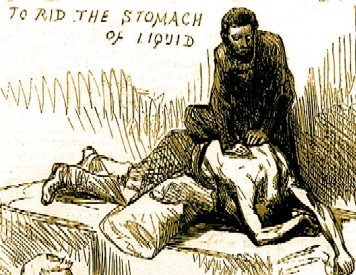
Dr. Howard's Method of Treating the Apparently Drowned,
From The Illustrated London News, Vol. 72, p308 (1878)
Alas, folk wisdom tends to have a life of its own. Sea surgeon John Moyle also advised "you are immediately to trice him up by his Heels with his Head downwards; so that the Water may the easier come out of his Body."2 (At least he doesn't suggest punching the poor soul in the stomach like Bradwell.)
John Atkins advocates several physical methods. He says that "it is usual to lay the Person over the Bilge of a Cask, the easier to disgorge [water], and [this] has some Reason in it, considered with the Circumstance. If the Stomach and Abdomen be very full, and the Patient senseless as it were, the jumbling and rowling quite suffocates; but when took up with Signs of Breathing and Life, the reclining of the Breast on a Pillow in this manner, with the Head downward... will make him throw up the Water"3. Note that Atkins' advice warns that rolling on a barrel "quite suffocates" the victim. While not as strong as later warnings, it does show that he recognized an inherent danger.
To recap, in the golden age of piracy's period literature, we find the following 'physical' methods suggested: 1. Hang the victim upside down. 2. Stroke, crush and drive in his stomach reasonably hard from the bottom to his throat. 3. Roll the drowning victim on a barrel. 4. Put the victim in an inclined position with the feet above the head. Each of these methods are designed to purge the unwanted water from him.
Physically Agitating and Moving a Victim, Post-GAoP
Because many different styles of agitating the victim are included in this section, I have chosen to list the data from the cases included in the two English versions of the Dutch society books in a table as you see below right. Physical 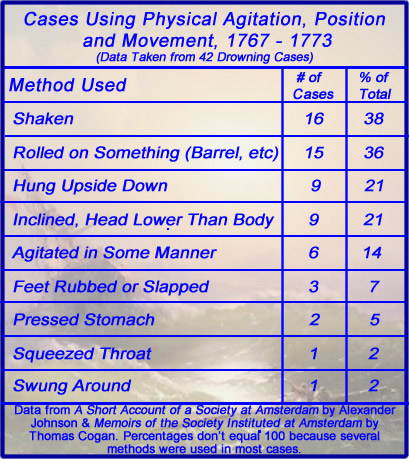
agitation was used in a total of 42 cases. The chart shows both the number of cases in which each method was tried as well as what percentage of the total it represents.
As John Atkins' comment presages, there was a movement against using many of the physical agitation methods after the golden age of piracy. The Dutch society Advertisement which details what they believed to be the best methods of revival doesn't mention any of the methods found in this chart. However, a few of them are recommended in the introduction to their fourth book of memoirs:
It would not be improper at times to incline the head of the patient, that they may evacuate water; but they must not remain long in that state, nor should it be in any degree violent.
The shaking of the carriage in which it may be necessary to convey them, may be serviceable, provided they lay upon straw.4
John Wilkinson advises that the victim's body "should be shook with the head downwards and excited,... to vomit up water it may have received down the throat."5 Bruhier d'Ablaincourt rather surprisingly suggests a way to get the victim to vomit water out is "to put him into a Tun [a large barrel], open at both Ends, and which for some Time is to be roll'd backwards and forwards in different Directions."6
You can imagine how bloodied and bruised an unconscious person would be after being rolled about in a large barrel! Fortunately, the vast majority of near post-period comments related to physical agitation of the nearly drowned are negative.
Post-GAoP Comments Against Physically Agitating and Moving a Victim
Alexander Johnson explains that, prior to 1767, "hardly any other attempts [to explain how to revive the nearly drowned] appear to have been made, but such as were suggested, at a time of confusion and distress, by ignorant people who for the most part are greatly misled by the unhappy prejudices prevailing in this matter."7 Based on what we've learned about the other methods suggested by period authors, we know this is not entirely true. Johnson seems to be primarily targeting the purveyors of folk wisdom.
Despite
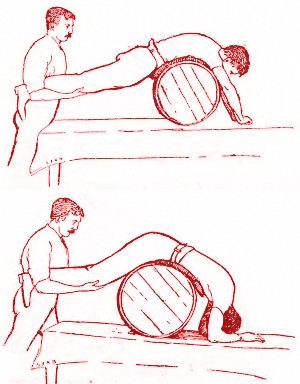
Rolling on a Barrel, from "The Mechanism Underlying the
Various Methods of Artificial Respiration" by Arthur Keith,
The Lancet, p. 828 (1909)
d'Ablaincourt's previous comments, various authors cry out against rolling a victim on a barrel. John Wilkinson starts his treatise on resuscitation by explaining, "Rolling in a cask is dangerous in some respects, and is much more so as it tends to lose time, which in such emergencies is extremely precious"8. Thomas Cogan quotes the author of the fourth book of Dutch memoirs as being "against the barbarous and destructive customs of rolling the patient in or upon a barrel, suspending them by the feet, or with a cord under the arms, which was the common practice of sailors."9
In one of the Dutch cases, Cogan reports that the patient, John Joseph Van Eel, "voided blood both upwards and downwards before he died. This seems to confirm to us [the Dutch society] how extremely pernicious is that method of rolling them upon a barrel. Yet in vain is it condemned by persons better instructed; the populace will not easily renounce prejudices supported by long custom."10 In that case, those who helped retrieve the nearly drowned man insisted upon rolling him on a barrel "in spite of the doctor's [Dr. Evans] attempts to dissuade them from it"11.
Another Dutch society case notes that a woman who had been revived died, probably because "she was inwardly bruised by the violent methods at first employed, particularly rolling on a barrel."12
Wilkinson also explains that "Hanging up the body by the feet is also not without danger, and is of no advantage at all. ...suspension, which is very pernicious ...contributes to increase the congestion, or load [of blood], which already lies upon the brain and choaks up the lungs."13 We have seen that the author of the fourth book of Dutch memoirs decries "suspending them [drowning victims] by the feet, or with a cord under the arms"14.
Bruhier d'Ablaincourt concurs, bringing humors into the mix. "It does not seem expedient to put the drown'd Person in a[n upside down] Position, which would prove uneasy as soon as the Humours of the Body should resume their ordinary Motion."15 Unfortunately, d'Ablaincourt leaves the topic without explaining why he thought the humors of the body would suffer from hanging a person "up by the Heels"16.
1 Stephen Bradwell, Helps For Suddain Accidents Endangering Life, p.97-8; 2 John Moyle, The Sea Chirurgeon, p. 98; 3 John Atkins, The Navy Surgeon, p. 269; 4 Thomas Cogan, Memoirs of the Society Instituted at Amsterdam in Favour of Drowned Persons for the Years 1767, 1768, 1770 and 1771, p. 69; 5 John Wilkinson, Tutamen Nauticum or The Seaman's Prevention from Shipwreck, Diseases and Other Calamities Incident to Mariners, p. 4; 6 Bruhier d'Ablaincourt, The Uncertainty of the Signs of Death, p. 205; 7 Alexander Johnson, A Short Account of a Society at Amsterdam Instituted in the Year 1767 For the Recovery of Drowned Persons, p. 7; 8 Wilkinson, p. 9; 9 Cogan, p. 69; 10,11 Cogan, p. 21; 12 Cogan, p. 64; 13 Wilkinson, p. 9; 14 Cogan, p. 69; 15 d'Ablaincourt, p. 205;

